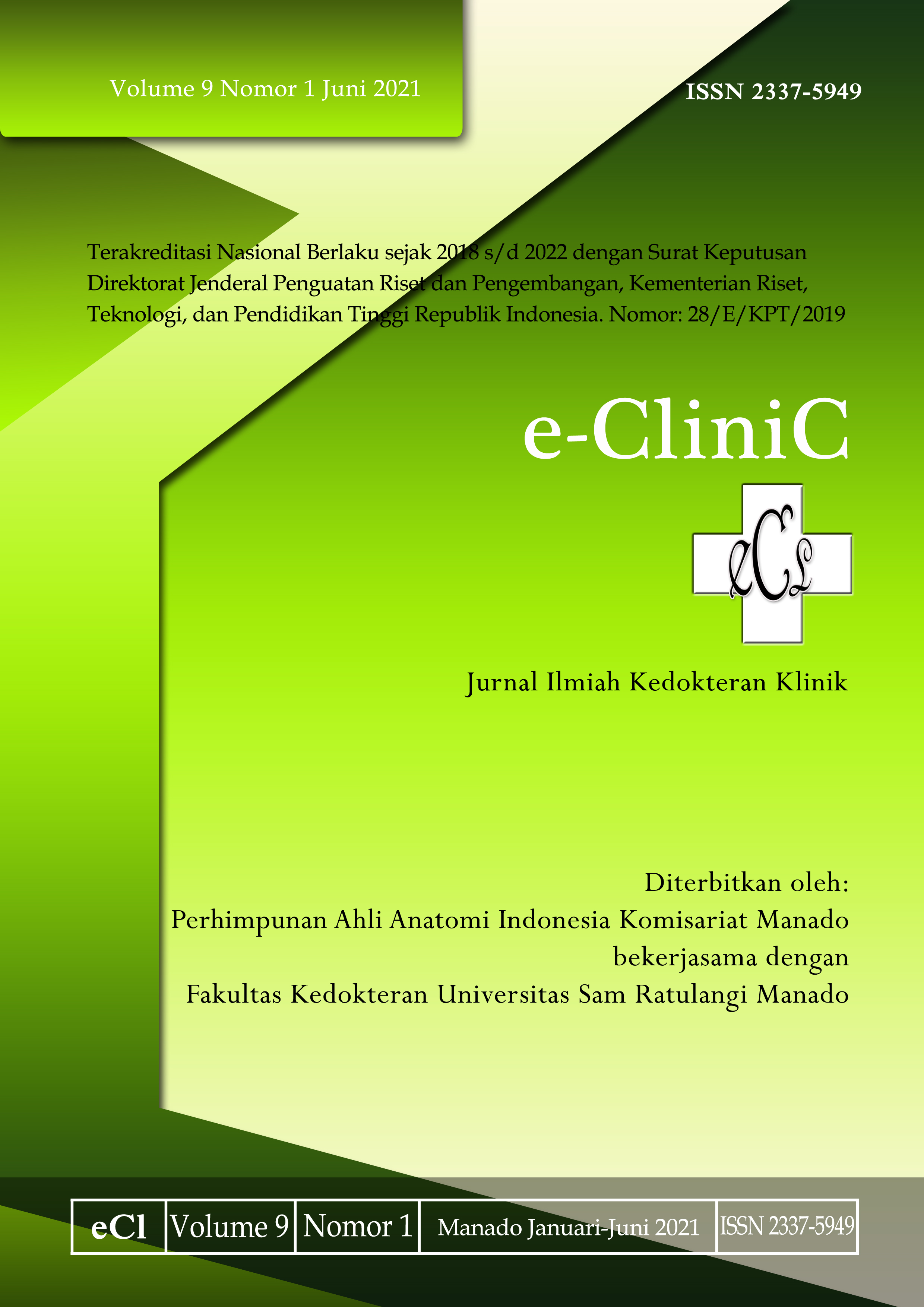Hubungan Kadar Laminin Serum dengan Klasifikasi CT Marshall dan GCS pada Pasien Cedera Otak akibat Trauma
DOI:
https://doi.org/10.35790/ecl.v9i1.32477Abstract
Â
Abstract: Elevated serum laminin levels in patients with traumatic brain injury (TBI) have been documented, but studies on its ability to predict outcomes based on the CT Marshall and Glasgow Coma Scale (GCS) classification are still unclear. This study was aimed to evaluate the relationship between serum laminin levels and Marshall CT as well as GCS classification in COT patients. This was an observational and analytical study with a cross-sectional design. A scan was used to determine the CT Marshall and GCS classification in order to obtain the level of consciousness. Venous blood samples for laminin were drawn less than 24 hours post-trauma. Age and gender were recorded, and the variable selection was carried out gradually. Proportional regression models were used to assess changes in the CT Marshall and GCS classification associated with laminin levels. The result showed that the 32 patients with COT had a mean laminin level of 818.4 pg/mL. Patients were distributed almost uniformly in the six categories of the CT Marshall classification. Furthermore, the final regression model consisted of patients with the CT Marshall IV-VI classification having a serum laminin level of 316.74 pg/mL (95% CI 206.88; 426.60 pg/mL; p<0.001) higher than that of I-III. Meanwhile, after controlling for a number of other variables, the difference increased to 401.06 pg/mL (95% CI 264.84; 563.28 pg/ mL; p<0.001). The individual consciousness levels were measured by using GCS which consist of an inverse relationship with serum laminin levels. Each increase in the mean of GCS rate decreased the laminin value to about 49.10 pg/mL (95% CI 23.33; 74.96 pg/mL; p<0.001). In conclusion, laminin has a significant correlation with the CT Marshall and GCS classifications in patients with COT.
Keywords: laminin, traumatic brain injury (TBI)
Â
Â
Abstrak: Peningkatan kadar serum laminin pada pasien dengan cedera otak akibat trauma (COT) telah didokumentasikan, namun studi tentang kemampuannya untuk memrediksi hasil berdasarkan klasifikasi CT Marshall dan GCS (Glasgow Coma Scale) masih terbatas. Penelitian ini bertujuan untuk mengevaluasi hubungan antara kadar laminin serum dengan klasifikasi CT Marshall dan GCS pada pasien COT. Jenis penelitian ialah analitik observasional dengan desain potong lintang. Pemeriksaan CT-scan digunakan untuk menentukan klasifikasi CT Marshall dan GCS digunakan untuk menentukan tingkat kesadaran. Sampel darah vena untuk laminin diambil kurang dari 24 jam pasca trauma. Usia dan jenis kelamin juga dicatat. Seleksi variabel dilakukan secara bertahap. Digunakan model regresi proporsional untuk menilai perubahan klasifikasi CT Marshall dan GCS terkait dengan kadar laminin. Hasil penelitian mendapatkan 32 pasien dengan COT yang masuk ke Instalasi Rawat Darurat Bedah (IRDB). Kadar rerata laminin ialah 818,4 pg/mL. Pasien didistribusikan hampir seragam dalam enam kategori dari klasifikasi CT Marshall. Model regresi akhir terdiri dari penderita dengan klasifikasi CT Marshall IV-VI rata-rata memiliki kadar laminin serum 316,74 pg/mL (95% CI 206,88; 426,60 pg/mL; p<0,001) lebih tinggi daripada mereka dengan kategori I-III. Setelah sejumlah variabel lain dikontrol, selisih tersebut bahkan naik menjadi 401,06 pg/mL (95% CI 264,84; 563,28 pg/mL; p<0,001). Tingkat kesadaran individu, diukur menggunakan GCS, sebaliknya memiliki hubungan terbalik dengan kadar laminin serum. Setiap kenaikan angka GCS rata-rata menurunkan nilai laminin hingga sekitar 49,10 pg/mL (95% CI 23,33; 74,96 pg/mL; p<0,001). Simpulan penelitian ini ialah laminin mempunyai korelasi bermakna dengan klasifikasi CT Marshall dan GCS pada pasien dengan COT.
Kata kunci: laminin, cedera otak akibat trauma (COT)
Downloads
How to Cite
Issue
Section
License
COPYRIGHT
Authors who publish with this journal agree to the following terms:
Authors hold their copyright and grant this journal the privilege of first publication, with the work simultaneously licensed under a Creative Commons Attribution License that permits others to impart the work with an acknowledgment of the work's origin and initial publication by this journal.
Authors can enter into separate or additional contractual arrangements for the non-exclusive distribution of the journal's published version of the work (for example, post it to an institutional repository or publish it in a book), with an acknowledgment of its underlying publication in this journal.
Authors are permitted and encouraged to post their work online (for example, in institutional repositories or on their website) as it can lead to productive exchanges, as well as earlier and greater citation of the published work (See The Effect of Open Access).







